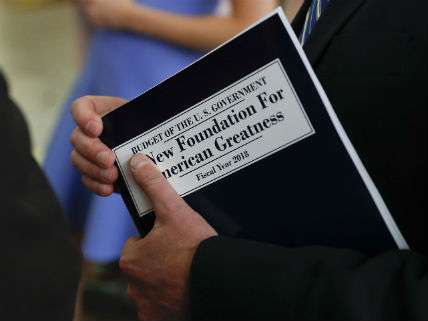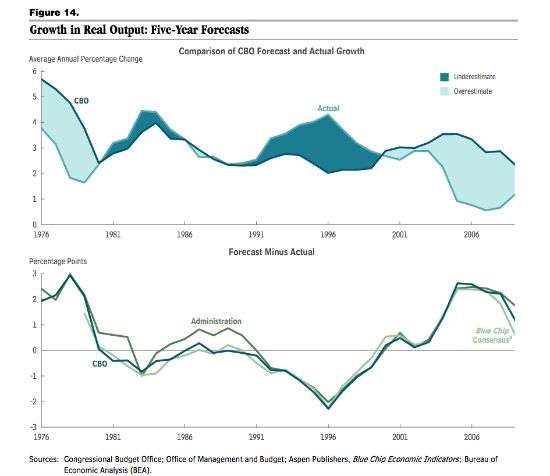Trump Budget: The Return of Rosy Scenario?
Congressional Budget Office projections vs. Office of Management and Budget projections

When Mick Mulvaney introduced the Trump administration's new budget, he rejected the Congressional Budget Office (CBO) projection that economic growth is likely to hover around 1.9 percent. "That assumes a pessimism about America, about the economy, about its culture, that we're simply refusing to accept," declared Mulvaney, who directs the Office of Management and Budget (OMB). "We believe that we can get to [3%] growth and we don't believe that's fanciful."
As it happens, the CBO periodically publishes an analysis comparing its projections, those of the OMB, and those made by the 50 economists surveyed for Blue Chip consensus. The latest analysis of the CBO's forecasting record was issued in February, 2015.
In general, all three measures tend to track one another. Between 1982 and 2012—the year for which we have the latest figures—the CBO's two-year forecasts of annual GDP growth rates were about 0.2 percent lower than what actually occurred; OMB's were 0.1 percent higher; and the Blue Chip consensus 0.1 percent lower. Looking at 5-year forecasts of real GDP growth, the CBO has been 0.1 percent higher than actual growth, OMB has been 0.4 percent higher, and the Blue Chip consensus was right on the money.
When large errors do show up in the CBO forecasts, they tend to reflect the difficulty of predicting recessions and booms, changes in productivity trends, and changes in oil prices.

The CBO's 5-year forecast record suggests that Mulvaney has succumbed to the "rosy scenario."
Editor's Note: As of February 29, 2024, commenting privileges on reason.com posts are limited to Reason Plus subscribers. Past commenters are grandfathered in for a temporary period. Subscribe here to preserve your ability to comment. Your Reason Plus subscription also gives you an ad-free version of reason.com, along with full access to the digital edition and archives of Reason magazine. We request that comments be civil and on-topic. We do not moderate or assume any responsibility for comments, which are owned by the readers who post them. Comments do not represent the views of reason.com or Reason Foundation. We reserve the right to delete any comment and ban commenters for any reason at any time. Comments may only be edited within 5 minutes of posting. Report abuses.
Please to post comments


Rosy Scenario was my nickname during that semester abroad in Tokyo.
It was also the code name for Trump's plan if Melania were to leave him. No, wait, that was the Rosie Scenario.
Sure it was, Losy Scenalio.
Wait, so we are complaining about a possibility that Trump is 1.1% more optimistic than the projections? And the projections have error in the ballpark of 1-2%? Eh I don't think this is a "rosy scenario" situation, perhaps just simply "optimistic". Now if he had gone out there and said something like 5% or 10% growth then yeah that's probably not happening. But 3% seems at least reachable.
It's not so much that 3% is impossible, but it's certainly an optimistic projection that makes Trump's budget math more plausible if it pans out. If it doesn't, it makes it look a lot worse. I don't like politicians making plans that are dependent on their optimistic scenarios.
Furthermore, while 3% growth or higher was normal before 2000, I believe we have only hit that number once or twice since then, and not even once since the last recession. Given that it seems highly unlikely to expect 3% growth every year going forward, unless you have confidence in Trump's ability to drastically boost growth (which I don't). That's also not considering that we are currently at about 8 years since the last economic contraction, and IIRC the longest ever was about 10 years during the 90s boom. If we don't have another recession in the next 5 years I'd be very surprised.
If it gives him cover to cut spending and taxes, why are we complaining?
Because he isn't going to cut spending and it means that the debt will be much larger than predicted?
There's a difference between cover and concealment.
Stocks are tumbling based on Trump's instability to handle government. Stocks might go back up when he leaves.
To be fair, Washington logic says spending money and blowing up the size of the place is a net win for our economic situation.
They clearly must believe this stuff by now.
Another 9/11 that killed every single pol would be a good thing even though a new crop of snakes would be right behind them. At least it would be gratifying to watch evil die.
So the guy we really need is Saint Patrick, is what you're saying? It has been a while since we had a Catholic in the Presidency. Not that it ended well the literally one time we had one...
I think we already have lots saint Patricks in there now.
I mean, how saintly is it to declare peter give up his shit to pay paul?
These people are practically angels on our shoulders.
Rand wouldn't take it. He has at least that much principle.
So do most trained economists. Very few questioned whether they got the sign wrong on the G.
Trump's budget is just as good as every other president's budget in my lifetime. That is to say, simply not good enough for the massive problems we face.
And not a budget. A reallocation of expenses from agency to agency.
Certainly they never hold the calling card of a budget for non-criminals like those of us that have to use budgets for allocation of necessity, savings for retirement, then maybe some fun.
Does anyone else remember the old joke about the economist, the engineer, and the doctor left on the desert island with three cans of beans? The doctor saves his can and goes looking for edible plants. The engineer tries to find sharp rocks and shells that open the can. The economist says "assume a can opener."
Does anyone remember that joke about Mikey, DanO, and Hihn stuck on a desert island with a radio with enough power to send out only one message?
Very often in H&R, images are embedded in posts that are too small to read comfortably. But there is rarely a link to go see a larger image. I find this irritating.
The one here is readable, but just barely.
Select "View Image" and expand it. Not perfect, but good enough for ones like this that aren't teeny tiny.
Thanks. I had already opened the image in a new tab. My browser, Opera, doesn't have a View Image option. But even if I downloaded it and opened it with an image viewer, it would look just like it did in a the new tab.
But, like you said, I could then blow it up but it would get fuzzier. All of that is too much trouble anyway. They need to link to these pictures.
I heard Trump's budget was cutting non-military discretionary spending by 2 percent per year for 10 years. If that's true, it's a good start. Where are the details?
Why not cut military spending as well? Seems like more unnecessary spending there.
No Social Security or Medicare cuts? What is the plan to keep those programs solvent?
This time it will be different, because Not Hillary.
Believe me. Believe me.
When large errors do show up in the CBO forecasts, they tend to reflect the difficulty of predicting recessions and booms, changes in productivity trends, and changes in oil prices
Not to mention 3 percent growth would trigger the FED to raise rates. Isn't 1 percent of Bush and Obama is $200 billion?